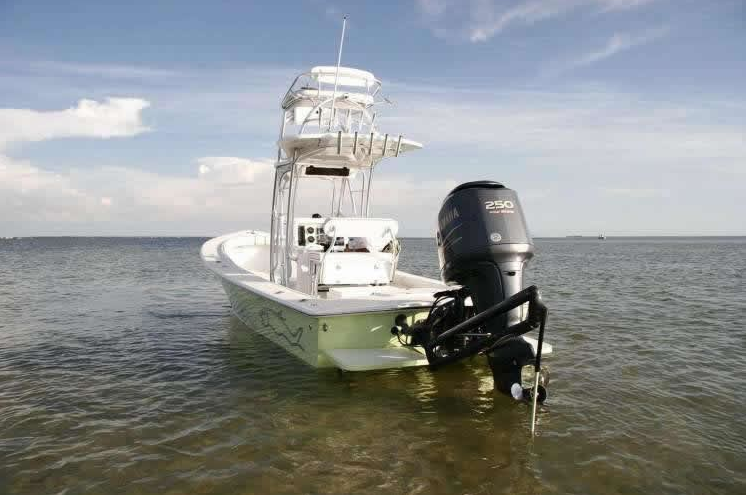
Power Pole
By Andrew Derr.
[dropcap]T[/dropcap]These days there are so many types of flats boat accoutrements on the market that it can be difficult to know what you need and what you do not. It basically comes down to making the boat move forward quietly and efficiently and making it stay stationery when needed. FLM.com has examined the products and de-mystified the subject to help you purchase what you need to conquer the flats.Push Poles
Push poles are required to move through the flat with stealth. For most flats aficionados, a pole from 18’-22’ will do best. I prefer them on the longer end of the spectrum because you get the forward propulsion with the end of you poling “stroke” as you walk your hands down the pole. That is to say, the last 4-5 feet of your push will give you the best angle to provide forward propulsion, as the pole is pointed away from the stern of the boat. With a shorter pole, I find myself having to reset my stroke just as I am getting the boat moving well.
Push poles can be made from an array of materials from bamboo and aluminum to fiberglass, graphite or composite. For our purposes, we will focus on fiberglass, graphite and composite materials. Fiberglass offers durability and flexibility for staking out but weighs considerably more than graphite. Graphite is very light but more brittle than fiberglass. And composite tries to marry the better characteristics of both materials. I prefer composite poles for the added durability and relative lightness in the hands. As well, a 1-piece push pole that contains no ferrules will cut down on weight and increase durability. Bear in mind that shipping a 22’ parcel can be challenging, so many companies make 2 or 3 piece poles that come with ferrules that can be epoxied into place. Also, a broken push pole can be repaired in the same manner of gluing a new ferrule at the break. Many push poles break when staking out the boat. Fiberglass poles are far more flexible and durable and should be considered for this purpose.
Points and Forks
Most manufacturers offer a couple options for each end of the pole. A simple nylon fork or Y at one end is standard and very useful for soft bottoms that will plug a simple point and require added effort to remove. At the other end is a point. Generally you can choose from a nylon point or a more durable nylon point with a metal tip. These metal tips last longer but can make noise when set on a hard or rocky bottom (metal meeting rock makes more noise than nylon hitting rock). Depending upon where you fish, you will want to choose accordingly
Staking Out
One aspect of the flats boat that is often overlooked is the need to keep it from moving at important times, like staking out a point where silver kings are known to travel. Historically, staking out with the pole has been the most popular method. Many guides still employ this method when fishing over a soft bottom. Another inexpensive option is to simply drop a small anchor (mushroom anchors work well for this) off of the stern with a short tether. Lifting this to move the boat is simple.
In the last 15 years or so, Powerpoles have become a very popular way to quickly anchor the boat in the shallow water. This is a mechanized device attached to the stern of the boat. With the push of a button, a motor (wired to boats battery) drives a stake into the floor of the flat to keep the boat staked in place. Another push of the button releases the vessel, allowing it to drift freely again. These are very convenient for those who find themselves staking frequently. Keep in mind, they are not inexpensive and will create added weight in the stern of the boat but for many seasoned flats anglers who stake frequently, the positives far outweigh the negatives.
One other cool product is called Hold My Pole. It is simply a bracket on the stern of the boat with a hole through which you can insert your push pole eventually driving it into the bottom of the flat itself. This is a cool item that weighs and costs very little ($150 ea.). For many, this offers the best of both worlds at a very reasonable cost.
Maintain
It is a good idea to take a couple of measures to protect your investment as push poles can cost upwards of $1000. Relax the pole when it is not being used on the boat. This will help insure it stays straight. Keep it out of direct sunlight when not using it if possible. UV rays can take a toll after many years. Some people build a container of PVC tubing or store it under there deck or house for this purpose. As well, a light coat of boat wax every now and then will help protect.
[information]Manufacturers
Biscayne Rod Company: One-piece and sectional fiberglass and composite push poles up to 22-feet / www.biscaynerod.com
Cabela’s : Composite 18-foot poles / www.cabelas.com
Carbon Marine : Mangrove and Loop carbon-fiber poles up to 26 feet / www.carbonmarine.com
Moonlighter : Fiberglass and carbon-fiber poles up to 20 feet / www.moonlighterpushpoles.com
Pole Cat Push Poles : Fiberglass and graphite poles up to 19 feet / www.polecatpushpoles.com
Skinnywater Products : Aluminum push poles up to 20 feet / www.skinnywaterproducts.com
Stiffy : Fiberglass, composite and graphite poles up to 24 feet / www.stiffypushpoles.com
Temple Fork Outfitters : Mangrove carbon-fiber poles up to 24 feet Available through TFO dealers /www.templeforkflyrods.com
Hold My Pole: Transom mounted bracket designed to use a push pole for your shallow water anchor needs / www.holdmypole.com
Power-Pole: Shallow water anchoring system for all small skiffs, bass boats, flats boats and bay boats / www.power-pole.com
[/information]

